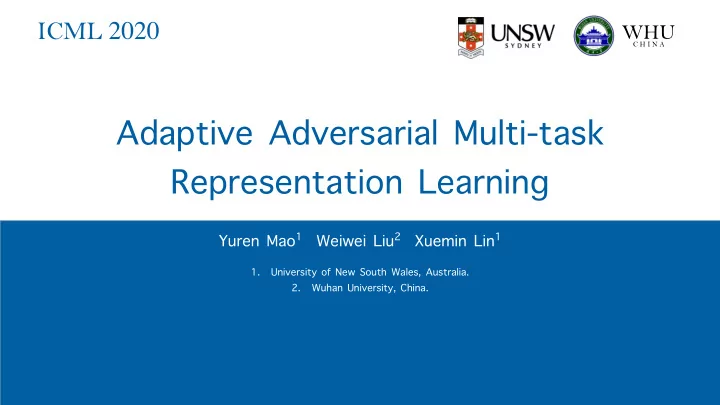

ICML 2020 WHU C H I N A Adaptive Adversarial Multi-task Representation Learning Yuren Mao 1 Weiwei Liu 2 Xuemin Lin 1 1. University of New South Wales, Australia. 2. Wuhan University, China.
Overview: Adaptive AMTRL (Adversarial Multi-task Representation Learning) Algorithm Forward Propagation Backward Propagation 𝜖 𝑀(𝜄 𝑡ℎ , 𝜄 1 ) 𝜖 𝑀(𝜄 𝑡ℎ , 𝜄 1 ) Task 1 Task Specific Layers Original MTRL 𝜖𝜄 𝑡ℎ Adaptive AMTRL 𝜖𝜄 1 𝑡𝑝𝑔𝑢𝑛𝑏𝑦(𝑋𝑌 + 𝑐) • …… …… Augmented 𝜖 𝜖 𝑀(𝜄 𝑡ℎ , 𝜄 𝑈 ) 𝑀(𝜄 𝑡ℎ , 𝜄 𝑈 ) Input Task T 𝜖𝜄 𝑈 𝜖𝜄 𝑡ℎ (a) Three 2-d Gaussian distributions (b) Discriminator (c) Relatedness changing curve …… Lagrangian Task Relatedness for • Discriminator Relatedness based MinMax … 𝑀 𝐸 (𝜄 𝑡ℎ ) 𝑀 𝐸 (𝜄 𝑡ℎ ) −𝜖 𝜖 AMTRL Weighting Strategy 𝜖𝜄 𝑡ℎ 𝜖𝑋 Shared Layers Gradient Reversal Layer Better Performance AMTRL PAC Bound � L D ( h ) − L S ( h ) ≤ c 1 ρ G a ( G ∗ ( X 1 )) + c 2 Qsup g ∈ G ∗ ∥ g ( X 1 ) ∥ 9 ln (2 / δ ) √ n + n 2 nT Negligible Generalization Error The number of tasks does not matter
Content • Adversarial Multi-task Representation Learning (AMTRL) • Adaptive AMTRL • PAC Bound and Analysis • Experiments
Adversarial Multi-task Representation Learning Adversarial Multi-task Representation Learning (AMTRL) has achieved success in various applications, ranging from sentiment analysis to question answering systems. h L ( h, λ ) = L S ( h ) + λ L adv Forward Propagation Backward Propagation min 𝜖 𝑀(𝜄 𝑡ℎ , 𝜄 1 ) 𝜖 𝑀(𝜄 𝑡ℎ , 𝜄 1 ) Task 1 Task Specific Layers Original MTRL 𝜖𝜄 𝑡ℎ 𝜖𝜄 1 Empirical loss: …… …… T n L S ( h ) = 1 𝜖 𝑀(𝜄 𝑡ℎ , 𝜄 𝑈 ) 𝜖 𝑀(𝜄 𝑡ℎ , 𝜄 𝑈 ) � � l t ( f t ( g ( x t i )) , y t i ) Input Task T 𝜖𝜄 𝑈 𝜖𝜄 𝑡ℎ …… nT t =1 i =1 Loss of the adversarial module: Discriminator MinMax … 𝑀 𝐸 (𝜄 𝑡ℎ ) 𝑀 𝐸 (𝜄 𝑡ℎ ) T n −𝜖 𝜖 1 L adv = max � � e t Φ ( g ( x t 𝜖𝜄 𝑡ℎ i )) 𝜖𝑋 nT Φ Shared Layers Gradient Reversal Layer t =1 i =1
Adaptive AMTRL Adversarial AMTRL aims to minimize the task-averaged empirical risk and enforce the representation of each task to share an identical distribution. We formulate it as a constraint optimization problem min L S ( h ) h L adv − c = 0 , s.t. and propose to solve the problem with an augmented Lagrangian method. 1 T L S ( h ) + λ ( L adv − c ) + r 2( L adv − c ) 2 . min h 𝜇 and 𝑠 updates in the training process.
Relatedness for AMTRL � N n =1 e j Φ ( g ( x i n )) + e i Φ ( g ( x j n )) Relatedness between task i and task j: R ij = min { , 1 } � N n )) + e j Φ ( g ( x j n =1 e i Φ ( g ( x i n )) R 11 R 12 R 1 T · · · R 21 R 22 R 2 T Relatedness matrix: · · · R = . . . . ... . . . . . . R T 1 R T 2 R TT · · · 𝑡𝑝𝑔𝑢𝑛𝑏𝑦(𝑋𝑌 + 𝑐) (c) Relatedness changing curve (a) Three 2-d Gaussian distributions (b) Discriminator
Adaptive AMTRL In multi-task learning, tasks regularize each other and improve the generalization of some tasks. The weights of each task influences the effect of the regularization. This paper proposes a weighting strategy for AMTRL based on the proposed task relatedness. 1 1 R 1 ′ 1 R, w = where 1 is a 1×𝑈 vector of all 1, and 𝑆 is the relatedness matrix. Combining the augmented Lagrangian method with the weighting strategy, optimization objective of our adaptive AMTRL method is T 1 w t L S t ( f t ◦ g ) + λ ( L adv − c ) + r � 2( L adv − c ) 2 . min T h t =1
PAC Bound and Analysis Assume the representation of each task share an identical distribution, we have the following generalization error bound. � L D ( h ) − L S ( h ) ≤ c 1 ρ G a ( G ∗ ( X 1 )) + c 2 Qsup g ∈ G ∗ ∥ g ( X 1 ) ∥ 9 ln (2 / δ ) √ n + n 2 nT Generalization Error Negligible The number of tasks does not matter • The generalization error bound for AMTRL is tighter than that for MTRL. • The number of tasks slightly influence the generalization bound of AMTRL.
Experiments - Relatedness Evolution Sentiment Analysis and Topic Classification. T R t = 1 Mean of � R tk . T k =0 Sentiment Analysis. Topic Classification
Experiments - Classification Accuracy Sentiment Analysis and Topic Classification. Sentiment Analysis. Topic Classification
Experiments - Influence of the Number of Tasks Sentiment Analysis. Relative Error: er MTL er rel = � T 1 1 er t STL T Error rate for the task ’ appeal ’ .
THANK YOU
Recommend
More recommend